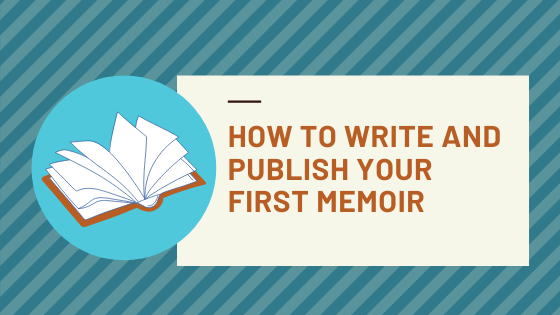The impulse to write a memoir can come out of nowhere like an epiphany. Suddenly, it is clear as day—you have a story to tell that you know others will enjoy reading. You don’t have to be a prophet or genius to be qualified to write a remarkable chapter of your life. You just have to be clear about the message you send the reader and dedicated to writing something truly compelling.
Once you’ve been bitten by the ‘got-to-write-a-memoir’ bug, you will soon find yourself obsessed with the daunting prospect of authoring a book. Suddenly, you are besieged with self-doubt and questions about writing a memoir and how to get your memoir published. If you are starting from square one, this blog is for you. Read on to learn more about writing a memoir book.
What is a Memoir?
A memoir is a nonfiction literary account of a specific experience or period in the author’s life. The author recants his or her memories of an experience taking care to share the events as they actually happened. Those who decide to undertake a memoir often do so, hoping that their personal experience will invoke inspiration or new insights in the reader.
Publishing a memoir is much more complicated than taking your journal entries and slapping a cover on them. Yes, your memoir should reflect who you are and what you have experienced, but it will require the skills of a gifted storyteller to be a success.
Writing a memoir book can be tricky, as there is much to consider before diving in. Get to know some memoir basics before beginning your project, such as:
- What are the different types of memoirs? Authors can approach a memoir from a wide range of angles. The different memoirs include humor, romance, survival, faith-based, tragedy, coming of age, travel, nostalgia, sports, and true confessions.
- What is the difference between a memoir vs. autobiography? A memoir represents only one particular experience or chapter of the author’s life, while an autobiography gives a full chronological account of the author’s entire life.
- How long should a memoir be? Before you begin writing your memoir, it is a good idea to know about how long your memoir should be. The sweet spot for length appears to fall in the area of 65,000-80,000 words.
7 Steps on How to Write a Memoir
So, how do you write a memoir, anyway?
When asked how do you write a memoir book, an oft-used piece of advice comes to mind: “Show, don’t tell.” You want to drive your story using vivid language and sensory details rather than reciting a narrative. You should draw the reader into your world to experience what you are writing about as if they were right there with you.
There are some practicalities to consider that will guide the writing process, including:
1. Decide on the period you want to write about.
Remember that this is a memoir vs. an autobiography. Select an extraordinary experience or period of your life on which to build your memoir. Begin jotting down specific memories and pivotal points that occurred during this time frame.
2. Develop your theme.
Asking yourself, “What do I want to say?” becomes the heart of your memoir, the takeaway message that you hope your story delivers to the reader. Plumb your soul to ask what you learned from your experience and what you wish to convey to help or inspire others.
3. Identify your audience.
Envision who will read your book, enthralled with your story, and then never lose sight of that persona. As you write your story, and later when marketing and promoting the book post-publication, having a clear picture of your target audience is essential to the book’s success.
4. Do your research.
Memories do fade. Prior to starting the writing process, pull together any historical materials that will help you keep your timeline accurate and your facts straight. Old emails, calendars, journals, letters, interviews and news reports from the era make excellent source material to resurrect the past accurately.
5. Outline the structure.
While the bulk of the story will likely follow a chronological order, this isn’t a rigid rule. You may decide to start the story with a high emotion event that happens later in the timeline but creates a powerful opener. Decide on the story’s general outline and jot down some chapter titles to give the project some structure, but feel free to shift from past to present as needed.
6. Use peak emotional turning points.
Remember that your memoir is a story and should follow a classic story-telling arc. The moments of high emotion drive the story and punctuate events that support the book’s theme and purpose. List out the emotional turning points that you strategically introduce, taking care to avoid tedious details and redundancy in your narrative.
7. Decide on a title.
Once the story is completed, you will have a much better idea of how the memoir should be titled. The story gathers personality and focuses as it is being written. It is wise to avoid becoming attached to a title at the outset, but rather to allow the story to choose the title for you.
For more detailed information about the nuts and bolts of memoir publication, it is always helpful to consult with memoir writing experts. Some of the best memoir writing books include:
- Handling the Truth, by Beth Kephart
- Your Life as Story, by Tristine Rainer
- Naked, Drunk, and Writing, by Adair Lara
4 Steps on How to Publish a Memoir
After you have painstakingly poured your heart and soul into your memoir project, you will need to face the less popular aspect of writing a memoir—the publishing process.
- Proofing, editing, and formatting. While an ambitious author may feel up to the task of DIY proofreading, editing, and formatting their own memoir, it is usually not recommended. Place your project into the hands of editing professionals who can spruce it up, as well as guide and execute the formatting process.
- Cover design. A stunning book cover is a powerful marketing tool. Your cover design should reflect the theme and tone of your memoir. Imagery, font selection, and color palette are important design elements. The cover design is another task best placed in the hands of a professional designer.
- Illustrations. Your memoir might benefit from illustrations. These might be simple sketches inserted on the first page of each chapter or as intrinsic storytelling elements. If you are a gifted artist, then you are good to go. If you are not but desire illustrations in your memoir, hire an artist.
- Distribution. Finally, your memoir is ready to go to market. You will decide if you want to offer both eBook and print editions and which distribution channels you want to use to sell your book.
Explore Next Steps to Get Your Memoir on the Market
Writing a memoir book can be both exhilarating and frightening at the same time. You are thrilled at the prospect of sharing your life experience with the world but may find the actual writing and publishing process intimidating. The experts at Gatekeeper Press can help get your memoir published, guiding you through the entire process with whatever services you need. To make your memoir the very best it can be, contact Gatekeeper Press today!

